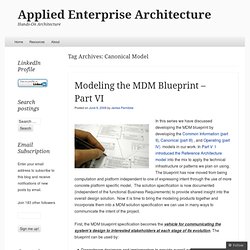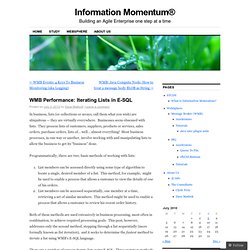

Canonical Model « Applied Enterprise Architecture. In part II and III of this series we discussed the Common Information and Canonical Models.

Because MDM is a business project we need to establish of a common set of models that can be referenced independent of the technical infrastructure or patterns we plan on using. Now it is time to introduce the Operating Model into the mix to communicate how the solution will actually be deployed and used to realize the benefits we expect with the business in a meaningful way. This is the most important set of models you will undertake. And sadly not accounted for in practice “in the wild”, meaning rarely seen, much less achieved. This effort describes how the organization will govern, create, maintain, use, and analyze consistent, complete, contextual, and accurate data values for all stakeholders. There are a couple of ways to do this. Strategy: Determine direction through goals, objectives, values and mission. Structure:Determines the location of decision making power. Like this: Like Loading...
Four Canonical Techniques That Really Work (Or Not) – Informatica Perspectives - The Data Integration Blog. Several years ago I had the fortunate opportunity to participate in a post-mortem study of a $100 million dollar project failure.

No one likes to be associated with a project failure, but in this case it was fortunate since the size of the write-off was large enough that it forced the team to take a very hard look at root causes and not just do a cursory analysis. As a result we finally got to the heart of a challenge that has been plaguing data architects and designers for 20 years – how to effectively use canonical data models. On paper, the concept of a canonical data model looks straightforward. Wikipedia defines it as: A design pattern used to communicate between different data formats. All large organizations have many applications which were developed based on different data models and data definitions, yet they all need to share data.
However, there is a catch. Canonical Data Model - Information Management Magazine Article. EXPERT - SOA de um jeito simples e fácil de entender. Xebia Blog - Part 3. Canonical Best Practices. “Canonical” is a typical IT industry buzzword - it is an overloaded term with multiple meanings and no clear agreement on its definition.

There appears to be at least three uses for canonical modeling. -- Canonical Data Modeling -- Canonical Interchange Modeling -- Canonical Physical Formats One of the challenges at most large corporations is to achieve efficient information exchanges in a heterogeneous environment. The typical large enterprise has hundreds of applications which serve as systems of record for information and were developed independently based on incompatible data models, yet they must share information efficiently and accurately in order to effectively support the business and create positive customer experiences. The key issue is one of scale and complexity and is not evident in small to medium sized organizations. Canonical Physical Format prescribes a specific runtime data format and structure for exchanging information. Anti-Patterns: Canonical Data Model Best Practice.
Canonical "Data" Model. Canonical Data Model visualized. Canonical "Data" Model. WMB Performance: Iterating Lists in E-SQL. In business, lists (or collections or arrays, call them what you wish) are ubiquitous — they are virtually everywhere.

Businesses seem obsessed with lists. They process lists of customers, suppliers, products or services, sales orders, purchase orders, lists of… well… almost everything! Most business processes, in one way or another, involve working with and manipulating lists to allow the business to get its “business” done. Programmatically, there are two, basic methods of working with lists: List members can be accessed directly using some type of algorithm to locate a single, desired member of a list. Both of these methods are used extensively in business processing, most often in combination, to achieve required processing goals. There are a number of ways to iterate lists using E-SQL.
The data used in this test is a 4MB (4,223KB) character XML document containing a list of 1500 SalesOrder documents. Sales Order SQL Script SalesOrder XML Excerpt Iteration Method 1 MsgFlow Main() Results.